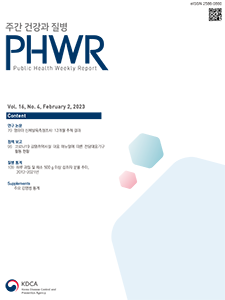Current Issue
Vol.16 No.4, February 02, 2023
-
Original Articles 2023-02-02
 0
0
 871
871
 228
228
Korea Infant Physical Growth Examination Survey: A 12 Months Follow-up Study
Hae-Eun Shin, Sun-Ja Kim, Kyungwon Oh*
Public Health Weekly Report 2023; 16(4): 79-95 https://doi.org/10.56786/PHWR.2023.16.4.1 Abstract
AbstractThe World Health Organization (WHO) developed the WHO Growth Standards for the assessment of the growth of infants. Korea Infant Physical Growth Examination Survey (KIPGroS) was implemented in 2020 to assess the growth standards of infants in the Republic of Korea (ROK). This study aimed to investigate the growth status of infants from birth to 12 months using the results of the KIPGroS collected from inception to October 2022. The height and weight records of 187 participants at birth, 123 participants at 6 months, and 60 participants at 12 months were obtained. All collected data were analyzed with t-test and one-way ANOVA using SPSS version 28.0 for windows. The height of boys in the ROK from birth to 12 months was relatively higher than the WHO standard. The weight of infants (boys and girls) in the ROK from 1 month to 12 months was relatively greater than the WHO standard. KIPGroS results showed that the weight and height boys were greater than those of girls from birth to 12 months, and parental height was significantly related to infants height. This report presented only the results of up to 12 months of the ongoing study. A comprehensive analysis of the participant’s follow-up data for 36 months will be used to revise the 2027 Korean Growth Chart.
-
Policy Notes 2023-02-02
 0
0
 576
576
 168
168
Activity Status of Dedicated Organizations to Response to Infectious Diseases: According to the COVID-19 Infection Vulnerable Facilities Response Manual
Jian Jeong, Sang-Eun Lee, Yeong-Jun Song, Mi Yu, Hye-Jin Kim, Yeon-Kyeng Lee, Hyunsuk Koo, Seung Jae Lee, Soohyeon Cho, Sae-Rom Choi, Young-Joon Park
Public Health Weekly Report 2023; 16(4): 96-108 https://doi.org/10.56786/PHWR.2023.16.4.2 Abstract
AbstractThe first edition of the “Standard Manual for the Prevention, Monitoring, and Investigation of Vulnerable Facilities” related to COVID-19 response was introduced and promulgated on May 19, 2022. The second edition (dated July 18, 2022) was revised, and a meeting was held between local governments and quarantine authorities to prepare a response system. From May 26 to June 30, 2022, the 1st Local Government Infection Vulnerability Facility Response Status Review Meeting was held six times, and the second meeting was held 10 times from July 28 to September 29, 2022. The organizations were established in June 2022, and as of September 2022, a total of 608 teams and 2,712 people of the city, county, and district public health center joint response team. A total of 57 teams and 266 individuals of the city and province dedicated response support team, and a total of 27 teams and 78 individuals of the city and province infection prevention and control support organization are being operated. To prevent and respond to infectious diseases, inspections in advance, prevention education, on-site response to group outbreaks, and the operation of task force teams are being conducted. The communication system between public health centers and facilities, provision of information sharing system, investigation of confirmed cases, and classification of facilities vulnerable to infection related to monitoring of cluster outbreaks were subdivided into eight types. Measures taken by infectious disease response organizations established by local governments can be expanded not only to COVID-19 response but also to responses to other infectious diseases.
-
QuickStats 2023-02-02
 1
1
 2923
2923
 458
458
Trends in the Proportion of the Population Consuming More Than 500 g of Fruits and Vegetables per Day, During 2012–2021
Public Health Weekly Report 2023; 16(4): 109-110 https://doi.org/10.56786/PHWR.2023.16.4.3

pp. 1433~1461
Most Keyword
?
What is Most Keyword?
- It is the most frequently used keyword in articles in this journal for the past two years.
Most Read
-
Waterborne and Foodborne Disease Outbreaks in the Republic of Korea, 2023
Myung-Jae Hwang, So Yeon Park, Hyungjun Kim, Se Jeong Yang, Sungchan Yang, Jin Seon Yang
Public Health Weekly Report 2025;18: 17-32 https://doi.org/10.56786/PHWR.2025.18.1.2 -
Implementation Plan for the Coronavirus Disease 2019 Vaccination for the 2024–2025 Season: Recommendations of the 6th Expert Committee on Immunization Practices
Hyewook Hwang, Wookeon Lee, Seohyeon Ahn, Young-Sook Choi, Seunghyun Lewis Kwon, Dongwoo Lee, Eun Hwa Choi, SokGoo Lee
Public Health Weekly Report 2025;18: 90-102 https://doi.org/10.56786/PHWR.2025.18.2.3
Editorial Office
+82-43-719-7569





 Full Text
Full Text Cite
Cite


